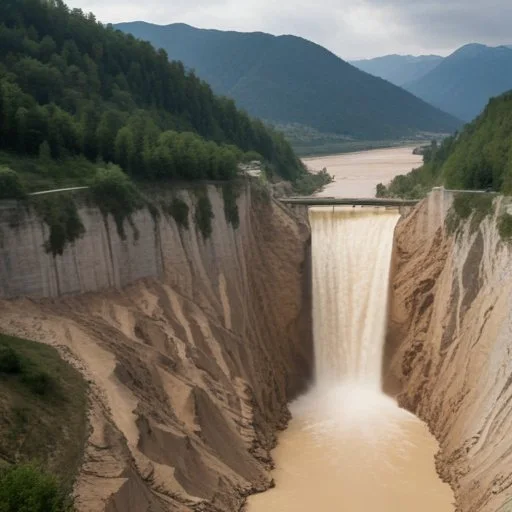The Vajont Dam disaster is infamous for being one of the deadliest dam failures in history, claiming the lives of over 2,000 people in a single, catastrophic event. On October 9, 1963, a massive landslide triggered a gigantic wave that overtopped the Vajont Dam in Italy, unleashing a torrent of floodwaters that swept away entire towns and villages.
The Vajont Dam was constructed in the 1950s in the picturesque town of Longarone, Italy, as part of a larger hydroelectric project. The dam was designed to provide electricity to the surrounding regions, but from its inception, the project was plagued by concerns over its safety. The dam was built in a seismically active area, and the nearby Monte Toc mountain was known to be unstable, with a history of landslides.
On that fateful day, a massive landslide occurred on Monte Toc, triggered by a combination of heavy rainfall and the dam's construction. The landslide sent a staggering 260 million cubic meters of rock and debris crashing down the mountain, creating a gigantic wave that traveled at speeds of up to 100 km/h. The wave overtopped the Vajont Dam, releasing a deluge of water that ravaged the towns of Longarone, Pirago, and Rivalta.
The Vajont Dam disaster had a profound impact on the local community, leaving deep emotional scars that would take decades to heal. The tragedy was met with widespread outrage and grief, with many calling for greater accountability and transparency in the construction industry.
One survivor, Alessandro Bonora, recalled the moment the wave struck: "I was submerged in water, and I thought it was all over. I thought I was going to die." Bonora's account is just one of many that highlight the human cost of the tragedy, a stark reminder of the devastating consequences of human error and natural disaster.
| Date | Event |
|---|---|
| 1950s | Construction of the Vajont Dam begins |
| October 9, 1963 | Massive landslide occurs on Monte Toc, triggering a gigantic wave that overtops the Vajont Dam |
| 1963-1965 | Investigations and inquiries into the disaster, leading to widespread reforms in dam construction and safety protocols |
The Vajont Dam disaster raised fundamental questions about the role of government and industry in ensuring public safety. The tragedy sparked a national conversation about accountability, with many calling for greater transparency and oversight in the construction industry.
The Vajont Dam disaster serves as a powerful reminder of the importance of safety and risk assessment in large-scale infrastructure projects. The tragedy has informed the design and construction of dams around the world, saving countless lives and preventing devastating tragedies.
In conclusion, the Vajont Dam disaster is a somber reminder of the importance of safety, accountability, and responsible engineering. The tragedy's legacy continues to shape the construction industry, serving as a powerful warning against the devastating consequences of human error and natural disaster.
The Vajont Dam disaster was not an isolated incident, but rather the culmination of a series of events that had been unfolding for years. The construction of the dam had been marred by controversy and disagreements between the Italian government, the Electric Power Company of Friuli-Venezia Giulia, and the local population.
In the years leading up to the disaster, several experts had raised concerns about the safety of the dam, citing the unstable geology of the area and the potential for landslides. However, their warnings were largely ignored, and the dam was constructed despite these risks.

Alessandro Bonora, a young engineer at the time, was one of the lucky survivors of the Vajont Dam disaster. Born in 1940 in Longarone, Bonora had always been fascinated by the dam and had often visited the construction site as a child.
Bonora's account of the disaster is a harrowing one, detailing the moment the wave struck and the chaos that ensued. His story has become an important part of the historical record, providing a personal and humanizing perspective on the tragedy.
The Vajont Dam disaster is often compared to another infamous dam failure, the Johnstown Flood of 1889 in Pennsylvania, USA. Both disasters were caused by a combination of human error and natural factors, and both resulted in devastating consequences.
However, there are also significant differences between the two disasters. The Johnstown Flood was caused by a combination of heavy rainfall and inadequate drainage, whereas the Vajont Dam disaster was caused by a massive landslide triggered by the construction of the dam.

The Vajont Dam disaster led to significant advances in the field of geology, with researchers developing new techniques for predicting and preventing landslides. The tragedy also spurred the development of more sophisticated safety protocols for dam construction, including regular monitoring and maintenance.
In the years following the disaster, engineers and scientists worked together to develop new technologies and methods for mitigating the risks associated with dam construction. These innovations have had a lasting impact on the industry, saving countless lives and preventing devastating tragedies.
The Vajont Dam disaster had a profound impact on the environment, causing widespread destruction and loss of life. The floodwaters released by the dam failure ravaged the surrounding countryside, destroying entire ecosystems and habitats.
The disaster also highlighted the importance of environmental impact assessments in large-scale infrastructure projects. In the years following the tragedy, there was a growing recognition of the need to balance human needs with environmental concerns, leading to more sustainable and responsible development practices.